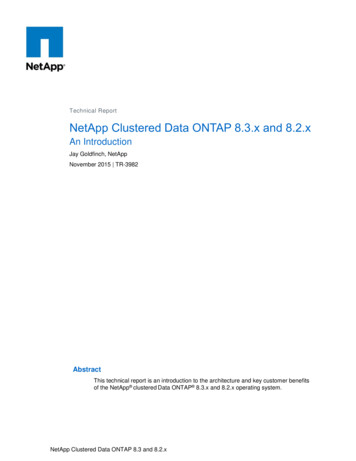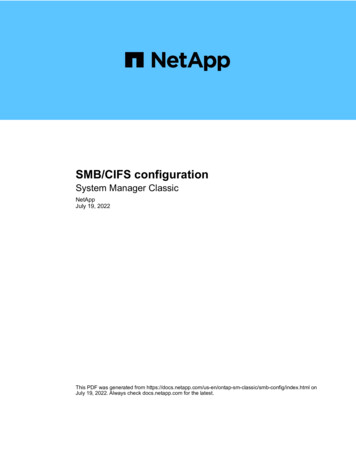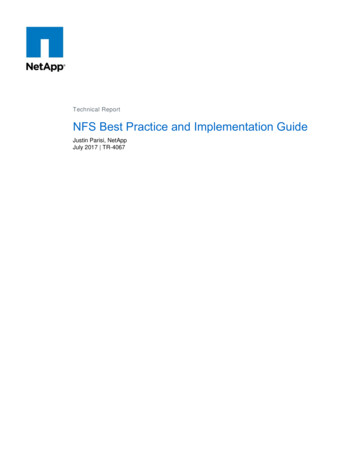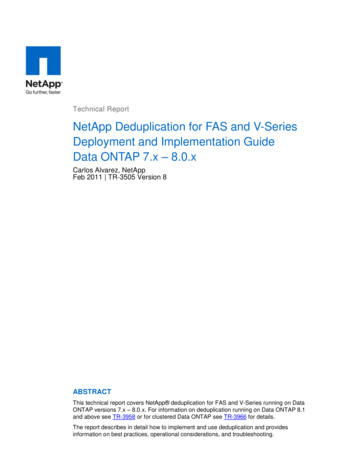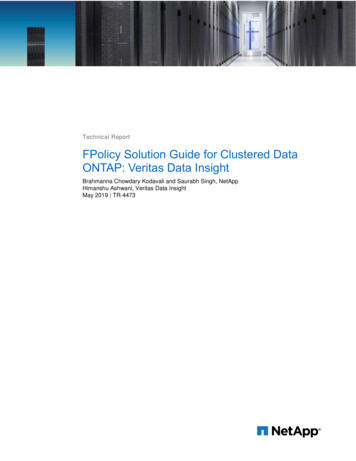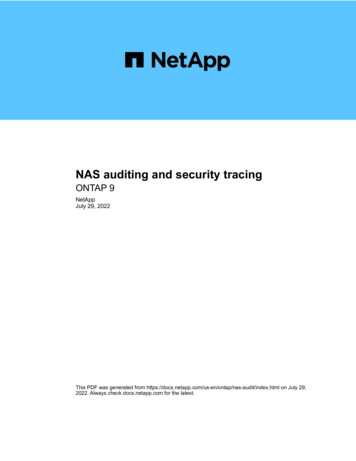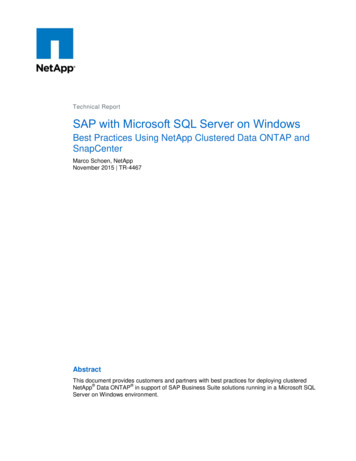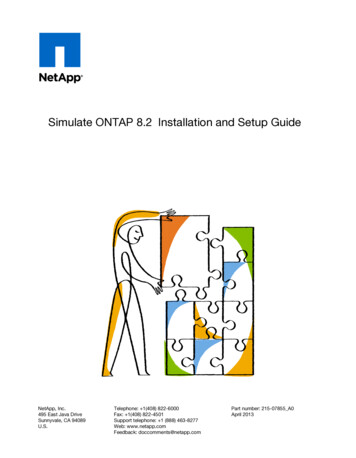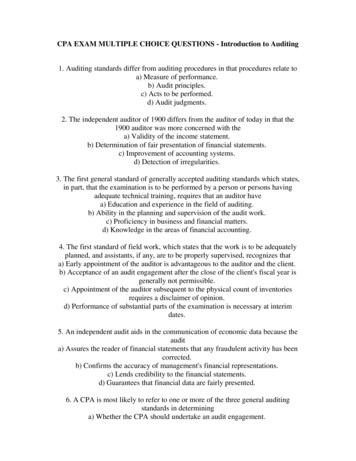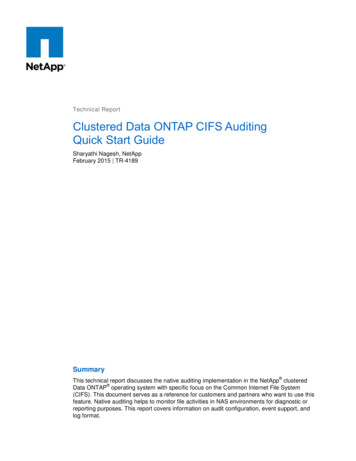
Transcription
Technical ReportClustered Data ONTAP CIFS AuditingQuick Start GuideSharyathi Nagesh, NetAppFebruary 2015 TR-4189Summary This technical report discusses the native auditing implementation in the NetApp clustered Data ONTAP operating system with specific focus on the Common Internet File System(CIFS). This document serves as a reference for customers and partners who want to use thisfeature. Native auditing helps to monitor file activities in NAS environments for diagnostic orreporting purposes. This report covers information on audit configuration, event support, andlog format.
TABLE OF CONTENTS123Introduction . 31.1Introduction to Clustered Data ONTAP .31.2Introduction to Data ONTAP Global Namespace .31.3Introduction to Data ONTAP Native Auditing Implementation .4Configuration of Native Auditing . 52.1Configuration of Native Auditing on Data ONTAP CLI .52.2Configuration of SACLs on the Storage Object .82.3Supported Audit Events .8Managing Audit Logs . 103.1Audit Log File Format .103.2Audit Log Record Format .103.3Audit Log Rotation .113.4Accessing Audit Logs .123.5Partial Logs .12Appendix . 12Audit Guarantee Feature . 12Performance Impact of Auditing . 12Relevant ONTAPI Interfaces for Configuring Auditing . 12Using Fsecurity to Set SACLs on Files and Folders . 13References . 13LIST OF TABLESTable 1) Supported access events in Data ONTAP 8.2.8Table 2) Supported access events in Data ONTAP 8.2 P2. .9Table 3) Supported logon/logoff events in Data ONTAP 8.3. .9Table 4) Supported Central Access Policy events in Data ONTAP 8.3. .10LIST OF FIGURESFigure 1) Data ONTAP: a scale-out architecture. .3Figure 2) Global namespace in clustered Data ONTAP. .4Figure 3) Staging volume creation in clustered Data ONTAP.5Figure 4) Configure audit policy workflow. .62Clustered Data ONTAP CIFS Auditing Quick Start Guide
1 IntroductionNative auditing helps to generate and manage file access logs on NetApp controllers. This feature helpsto meet industry requirements such as compliance, secure log management, and intrusion detection. Astorage administrator can use this feature to monitor CIFS/NFS user activities on files and folders.Native auditing implementation for clustered Data ONTAP is supported from version 8.2 onward. Thisreport describes how to configure auditing in clustered Data ONTAP, access log files, and interpret loginformation. Native auditing provides a file auditing framework that supports both CIFS and NFSprotocols. Auditing in CIFS is based on NTFS, system access control lists (SACLs), or NFS 4.x accesscontrol lists (ACLs). This document focuses exclusively on auditing in CIFS file activity and best practices.For NFS-specific auditing information, refer to TR-4067: Clustered Data ONTAP NFS Best Practice andImplementation Guide.1.1Introduction to Clustered Data ONTAPClustered Data ONTAP supports scale-out architecture that can be used to add multiple NetApp nodesthat provide scalability for storage capacity and performance.Figure 1) Data ONTAP: a scale-out architecture.1.2Introduction to Data ONTAP Global NamespaceThe namespace offered by a storage virtual machine (SVM, formerly called Vserver) is called a NetAppglobal namespace. It acts as a container for all storage object servers by the SVM and identifies eachsuch object with a unique identity. NetApp global namespace supports combining volumes across thecluster to provide a single namespace. Junction points provide means to join volumes together, creating asingle namespace. This capability provides additional flexibility in laying out namespaces when comparedto Data ONTAP 7-Mode.3Clustered Data ONTAP CIFS Auditing Quick Start Guide
Figure 2) Global namespace in clustered Data ONTAP.The global namespace created using junction points has the following characteristics: Stitching volumes together is transparent to the clients. CIFS shares can be created on volumes, qtrees, or folders.1.3Introduction to Data ONTAP Native Auditing ImplementationThe native auditing framework enables a storage administrator to monitor user actions such as accessand modification of data files. This framework can be quickly configured to monitor file activities for bothcompliance needs as well as for short-term diagnostic purposes.The native auditing feature in Data ONTAP 8.2 supports both CIFS and NFS protocols. A CIFS or an NFSlicense is required to configure this feature. To support reliable auditing, the audit information is stored onthe disk instead of in memory so that in the event of a node or cluster crash, the latest audit information iscommitted to the disk.To enhance performance and the user experience, this audit information is stored in a specific location ineach aggregate. This location is referred to as the staging volume. The log records in the staging volumeare consolidated into a single log file on a periodic basis. The location and consolidated log file arespecified during audit configuration. This process is explained in section 2.1.The creation of staging volumes is transparent to end users. After the creation of an audit policy on anyone SVM in the cluster, a staging volume is created on all the aggregates in the cluster. From then on, allother SVMs use the existing staging volumes. Each staging volume consumes 2GB of free space andneeds to be provisioned during configuration.Staging volumes are created under a cluster SVM context, not under the data SVM context. A stagingvolume can be accessed only by the Cserver administrator. The Cserver administrator can resize thestaging volume in diag-mode by using the vol resize option.4Clustered Data ONTAP CIFS Auditing Quick Start Guide
If the staging volume gets filled up, the CIFS operations will be blocked. NetApp recommends followingthe best practices for configuring log rotation, destination volumes, and guaranteed auditing that are listedin TR-4191: Best Practices Guide for Clustered Data ONTAP 8.2.x and 8.3 Windows File Services.NetApp does not recommend resizing or changing the staging volume because the size is determinedafter extensive deliberation.For example, in Figure 3, the SVM is spread across two nodes and three aggregates. Enabling auditingwould create a staging volume in each of the aggregates and by default would take up 2GB of space foreach aggregate.Figure 3) Staging volume creation in clustered Data ONTAP.Log consolidation is scheduled every 10 seconds, and scheduling depends on the available CPUbandwidth in the user space. Log consolidation cannot be configured. This point is explained in section2.1.2 Configuration of Native AuditingThis section introduces the configuration required to enable auditing on clustered Data ONTAP for SVMcontext and configuration of SACLs on files and folders.2.1Configuration of Native Auditing on Data ONTAP CLIThe SVM audit command enables or disables auditing, defines log location files, manages log rotation,and so on.You can configure auditing by using either the cluster admin or SVM vsadmin credential. With the clusteradmin credential, you can apply configuration to any SVM in the cluster; the SVM vsadmin credentialrestricts you to only the specific SVM context. The examples in this report are for the cluster context. Inthe cluster context, you can access/modify/create the audit config for all the SVMs in the cluster. In theSVM context, you can access only the SVM audit config.5Clustered Data ONTAP CIFS Auditing Quick Start Guide
Additionally, enabling auditing requires the configuration of SACLs. To configure SACLs on files andfolders, users needs to have SeSecurity privileges. By default, only the local user BUILTIN\administratorhas this privilege.To assign SeSecurity privileges to a user, run the following command:vserver cifs users-and-groups privilege add-privilege -vserver vserver name -user-or-group-name user -privileges SeSecurityPrivilegeWorkflow for Configuring Audit Policy on SVMThe following flow chart captures the workflow for enabling native auditing in clustered Data ONTAP 8.2and later. This report primarily explains audit configuration through the CLI; equivalent operations are possible through the NetApp ONTAPI library as well. To configure through ONTAPI, refer to theAppendix.Figure 4) Configure audit policy workflow.Create an Audit PolicySpecify: Log destination, log rotation, log size, etc.Enable Audit PolicyConfigure SACLs on the FoldersActivity: Configure through Explorer, Windows APIFile Access Will Generate LogsActivity: Log files will be generated at destinationDisable Audit PolicyActivity: Consolidating partial records and stop auditingDelete Audit PolicyPolicy will be removed from the SVMCreate an Audit Policy on SVMThe first step for enabling auditing on an SVM is to create an audit policy. The SVM name, destinationpath for saving logs, and log rotation parameters are required as inputs. You can create only one activepolicy for each SVM. This command will either: Create new staging volumes if the staging volume does not already exist in the data aggregate. Share an existing staging volume in the data aggregate without compromising on multi-tenancy. Insome instances, the staging volume can be shared by multiple SVMs.6Clustered Data ONTAP CIFS Auditing Quick Start Guide
By default, the staging volume consumes 2GB of space. The audit will fail if there’s insufficient free spaceon the aggregate in which the data volume resides.Creating Policy Based on Log SizeIn the following example, an audit policy is created for the specified SVM with log location specified in thedestination field. The destination path is a path to the folder location and should have been createdpreviously. The size of the log file is specified through the rotate-size field. The rotate-limit parameterspecifies the maximum number of log files that will be retained in the specified destination. Log filesbeyond this value will be overwritten. A value of zero indicates unlimited log files; in this case, the numberof log files will be limited by the available free space in the destination. NetApp does not recommendsetting this value to zero. When the destination volume is filled up, the CIFS client operations will beaffected.vserver audit create -vserver vserver name -destination unix path -rotate-size size MB rotate-limit Number of log files When log files reach the specified rotate size, the action triggers log rotation. The log rotate size shouldbe greater than 1024KB and the default value is 100MB.Creating Policy Based on TimeThis example illustrates creating an audit policy for a specified SVM with the log location specified in thedestination field by using the following command:vserver audit create -vserver vserver name -destination unix path -rotate-schedule-minute minute of the hour -rotate-limit Number of log files Note:The rotate-limit parameter specifies the maximum number of log files that will be kept in thespecified destination.The rotate-schedule parameter defines how often the audit log file will be rotated. For moredetails about log rotation, refer to section 3.3.Enable an Audit Policy on SVMAfter the audit policy is created, it needs to be enabled for audit action to begin. To enable the auditpolicy, use the following command:vserver audit enable -vserver vserver name Disable an Audit Policy on SVMThis command consolidates any partial audit records present in the staging volumes into the consolidatedaudit log file and stops further logging of audit records:vserver audit disable -vserver vserver name Delete an Audit Policy on SVMDeleting the audit policy can free space for data by deleting the staging volume. If the staging volume isused by another SVM, deletion is not possible. Staging volumes are deleted only when all the SVMreferences are deleted.An audit policy can be deleted by using the following command:vserver audit delete -vserver vserver name 7Clustered Data ONTAP CIFS Auditing Quick Start Guide
Modify an Audit Policy on SVMThe audit modify command modifies the parameters previously created for an audit policy. Thiscommand can be used to modify log destination location and rotation policies such as number ofconcurrent log files, log rotation triggers, and so on.vserver audit modify -vserver vserver name -destination unix path -rotate-size 100MB -rotatelimit 02.2Configuration of SACLs on the Storage ObjectAfter enabling the audit policy at the SVM level, configure SACLs on files, folders, or shares.SACLs can be configured on files and folders as follows: By using client applications such as Windows Explorer From script/application using appropriate Windows APIs From file-directory (Fsecurity) command through the CLISACLs can be configured on shares as follows: By setting SACLs on the root of the share from the Windows clientNote:2.3Windows RPCs are currently not supported. Configuration through MMC or a dependentapplication is not possible.Supported Audit EventsThe auditing framework supports the logging of file and folder access operations. Table 1 lists theequivalent Windows object access operation ID. Both success auditing and failure auditing are supportedfor each of these operations.Table 1 lists the supported events. The mapping of these events and the Windows events is on a besteffort basis. Some of the information present in a Windows event might not be provided in the DataONTAP environment; for example, Windows audit records capture process ID and process name, whichis not possible in Data ONTAP audit records.Access Events Supported in Data ONTAP 8.2Native auditing was introduced in the first release of clustered Data ONTAP 8.2. We provided support tobasic audit events that will help in tracking file operations and generating required audit trails.Table 1) Supported access events in Data ONTAP 8.2.Windows Event IDEvent NameDescription4656Open objectA handle to an object is requested. This corresponds to eventID 560 in Windows Server 2003 (W2k3) and earlier.Create object4663Read objectWrite objectGet object attributesSet object attributes46648Hard linkAn attempt was made to access an object. This corresponds toevent ID 567 in W2k3 and before. This event documents theoperations performed against data objects. This event logsoperations that take place between the open and theclose events for the object.Read and write events are optimized to log only the first readand write to make them more effective.An attempt was made to create a hard link. A hard link is apointer to another file in the same file system.Clustered Data ONTAP CIFS Auditing Quick Start Guide
Windows Event IDEvent NameDescription9999Rename objectAdded by NetApp. This ID captures the object renameoperation. This is currently not supported by Windows as asingle event.9998Unlink objectAdded by NetApp. This ID captures the object unlink operation.This is currently not supported by Windows as a single event.Note:NetApp does not support the close object event, event ID 4658, because it was creatingunwanted notifications.Note:In Data ONTAP 8.2, the monitoring delete operation is supported only through event ID 4656.The event has all the information required for identifying the delete event. The event has desiredaccess fields that specify if the file is opened with delete intent, helping to identify deleteoperations.Access Events Supported in Data ONTAP 8.2 P2The SMB protocol supports two methods of deleting files. This support was provided by adding the twoadditional events listed in Table 2. NetApp strongly recommends deploying Data ONTAP 8.2 P2 andhigher to leverage the benefits of these additional events.Table 2) Supported access events in Data ONTAP 8.2 P2.Windows Event IDEvent NameDescription4659Object deleteA handle to object is requested with intent to delete. Itcorresponds to event 563 in W2K3.4660Object deleteThis event is generated when the object under consideration isdeleted. It corresponds to event 564 in W2K3.Access Events Supported in Data ONTAP 8.3Two additional categories of events introduced in clustered Data ONTAP 8.3 are: CIFS logon/logoff events Central Access Policy (CAP) staging eventsTable 3) Supported logon/logoff events in Data ONTAP 8.3.9Windows Event IDEvent NameDescription4624Local user/Networkuser logonAn account was successfully logged on and a CIFS session isestablished. It corresponds to event 528 and 540 in W2K3.4625Logon failuresAn account was unsuccessful in logging and establishing aCIFS session. It corresponds to event 529–537 and 539 inW2K3.4634Local user/Networkuser logoffAn account was successfully logged out and a CIFS session isdisconnected. It corresponds to event 538 in W2K3.Clustered Data ONTAP CIFS Auditing Quick Start Guide
Table 4) Supported Central Access Policy events in Data ONTAP 8.3.Windows Event IDEvent NameDescription4818Object access,central policy stagingThese sets of events are used to evaluate the impact of CentralAccess Policies configured through AD and applied through thegroup policy objects on SVMs.Auditing of these events can be enabled during audit policy configuration starting from Data ONTAP 8.3onward.vserver audit create -vserver vserver name -destination unix path -events cap-staging,fileops,cifs-logon-logoff -format evtx -rotate-size size MB -rotate-limit Number of log files For more information about describing security events, refer to MS KB Article ID: 947226: Description ofsecurity events in Windows Vista and in Windows Server 2008.3 Managing Audit Logs3.1Audit Log File FormatIn Data ONTAP 8.2, audit logs are generated in XML format only. To convert the audit log to WindowsEVTX format, use the off-box tool NetApp EVTX Converter. You can find more information about theEVTX Converter in the community blog.Starting with clustered Data ONTAP 8.2.1, both XML and EVTX formats are supported as log formats.They are provided as options during audit policy configuration. EVTX is used as the default log formatunless a different format is specified during audit policy configuration.You can change the audit log file format to the EVTX format during audit policy configuration starting withData ONTAP 8.2.1.vserver audit create -vserver vserver name -destination unix path -format evtx -rotate-size size MB -rotate-limit Number of log files Log File Naming ConventionThe following is the naming convention of the consolidated log file format, which cannot be configured:audit vservername D yyyy - MM - DD -T HH - MM - SS milliseconds.Xml3.2Audit Log Record FormatThe file audit records are saved in an audit log file. The records follow a format similar to the Windowsevent framework.Schema of Log RecordsAlthough the log record format is closely aligned with the Windows EVTX format, it follows the NetAppproprietary format. This was done to accommodate the unique nature of the underlying Data ONTAPframework and to improvise on the existing framework wherever possible.Detailed documentation of the event schema is shared in the community link.10Clustered Data ONTAP CIFS Auditing Quick Start Guide
Path of File in NotificationsThe path information provided in logs will include only the relative path from the root of the containingvolume. The user needs to construct the absolute path information from the volume ID, also called msID,and the information available in the file handler field of the log record.Here is an example:If there are two volumes—vol0 and vol1—with vol0 joined on / and vol1 on /home/userA, the path/home/userA/division/team/prod has /home/userA in vol0 and /division/team/prod in vol1.When the file in /home/userA/division/team/prod is accessed, only the path /division/team/prod isavailable in the notification. The mount point of the volume vol1, which is /home/userA, is called thejunction point of the volume vol1.To construct the absolute path name, the information available outside the log records must be used.Clustered Data ONTAP can be queried with a volume-get-iter ONTAPI call with unique msID toretrieve its junction point. A user developing this support can cache the msID to junction path mapping toavoid calling it every time. Since the namespace will not change frequently, one-time operation to buildthe namespace should be sufficient.Note:3.3When a new volume is added, the SVM has to be queried again to find the junction point. In rareinstances, if the volumes are remounted on a new junction path, the global namespace will bechanged. In such instances, periodic querying with volume-get-iter to update the volume–junction path mapping is required.Audit Log RotationThe audit log rotation feature rotates the active log files to which the audit records are written. The logrotation can be configured for time or size.If the log size and log rotation parameters are not specified, the default values will be used. The defaultvalue is log rotation based on a log size of 100MB. New logs will be created until the destination volumehas free space. The number of concurrent files kept for log management can be changed with the rotatelimit parameter.Log Rotation Based on TimeLog rotation is based on calendar date and time. The parameters supported are: Month Day Time: Specific hour and minute of the day. Specifying in minutes is mandatory. For example, onspecifying the minute field as 45, at every 45th minute of the hour a new log file will be generated.The following command creates new log files on specific days of the week:vserver audit modify -vserver vserver name -destination unix path -rotate-schedule-monthFebruary,March -rotate-schedule-dayofweek Sunday -rotate-schedule-hour 22 -rotate-schedule-minute45 -rotate-limit Number of log files Log rotation can be based on calendar date and time. The parameters supported are:vserver audit modify -vserver vserver name -destination unix path -rotate-schedule-monthFebruary,March -rotate-schedule-day 22 -rotate-schedule-hour 22 -rotate-schedule-minute 45 rotate-limit Number of log files Log Rotation Based on Log SizeLog rotation can be based on log size. This can be configured using the following command:11Clustered Data ONTAP CIFS Auditing Quick Start Guide
vserver audit modify -vserver vserver name -destination unix path -rotate-size size MB rotate-limit Number of log files 3.4Accessing Audit LogsAudit logs will be saved in the destination location specified during audit configuration. The logs can beaccessed over the data access path. The destination path and the file can be accessed through CIFSshares. Access can be restricted with share-level ACLs or through folder- or file-level ACLs. Similaraccess is possible through the NFS export path as well.Note:3.5Access to audit logs is through a pull mechanism and retrieved over NFS, CIFS, or another fileaccess protocol method. Audit logs are not integrated with the syslog framework and hence logscannot be accessed through the push mechanism.Partial LogsDuring cluster failovers, the audit engine cannot consolidate the complete Vserverized logs. In this case,the audit log file name will indicate that it is a partial file. As soon as the node boots up, the audit enginewill consolidate the records and order them chronologically.AppendixAudit Guarantee FeatureThis feature supports guaranteed logging of audit events. This action is useful when auditing is highlycritical, either because of organizational policies or because of regulatory requirements. The featureenables log records to be written to disk before file operations are completed, leaving a highly reliableaudit trail. Enabling guaranteed auditing without following the auditing best practices can cause clientdisruptions. In case records cannot be committed to the disk because of insufficient space in the stagingvolume or the destination volume client, I/Os will be blocked. This feature is enabled by default andtherefore care should be taken when configuring log rotation and destination volume size. They need tobe configured as per the best practices listed in TR-4191: Best Practices Guide for Clustered DataONTAP 8.2.x and 8.3 Windows File Services.This feature can be configured in diag-mode as follows:vserver audit modify -vserver vserver name -destination unix path -rotate-size 100MB -rotatelimit 0 -audit-guarantee true falsePerformance Impact of AuditingEnabling auditing on CIFS has marginal impact on latency and CPU utilization. NetApp completedextensive testing to characterize the performance impact of auditing and recommends following our bestpractices to minimize the performance impact.Enabling auditing on multiple SVMs within a single cluster will affect performance. We tested DataONTAP 8.2.1 with 50 SVMs with minimal performance impact. Consider the number of audit-enabledSVMs before deploying the auditing feature.Relevant ONTAPI Interfaces for Configuring AuditingThe auditing features can be configured either through the command-line interface (CLI) or through APIs. Data ONTAP APIs (ONTAPI or the NetApp Manage ONTAP storage development kit) supported withauditing allow configuring auditing remotely. Information about ONTAPI interfaces can be found in NMSDK documentation available at the NetApp Developer Community. The developer forum is a usefulreference for developers with technical queries.12Clustered Data ONTAP CIFS Auditing Quick Start Guide
Note:Cluster ONTAPI interfaces are supported from NM-SDK 4.2 and later.Table 4) List of audit ONTAPI interfaces added to clustered Data ONTAP.ONTAPI rovides audit configuration details for a particular ns the total number of audit configuration entries/records in thetable.fileservice-audit-config-get-iterProvides audit configuration details for all the SVMs.fileservice-audit-config-createCreates audit configuration for a particular SVM.fileservice-audit-config-destroyDeletes audit configuration for a particular SVM.fileservice-audit-config-modifyModifies the audit configuration for a particular SVM.fileservice-audit-enableEnables auditing for a particular SVM.fileservice-audit-disableDisables auditing for a particular SVM.Executing the ONTAPI InterfacesAlthough some of the ONTAPI interfaces run only in clustered context and some only in SVM context, afew ONTAPI interfaces run in both. Keep this in mind before calling ONTAPI. Cluster APIs. These APIs are executed against the cluster-mgmt IP using cluster administrationcredentials. Vserver APIs. These APIs are executed using one of the following options: Calling ONTAPI against an SVM LIF using SVM admin credentials Calling ONTAPI against the cluster-mgmt IP with cluster admin credentials, but using tunnelingUsing Fsecurity to Set SACLs on Files and FoldersSACLs can be configured from the vserver security file-directory command family throughthe CLI. The command family was known as the Fsecurity feature in Data ONTAP 7-Mode.This command can be used to construct Security De
protocols. Auditing in CIFS is based on NTFS, system access control lists (SACLs), or NFS 4.x access control lists (ACLs). This document focuses exclusively on auditing in CIFS file activity and best practices. For NFS-specific auditing information, refer to TR-4067: Clustered Data ONTAP NFS Best Practice and Implementation Guide.
